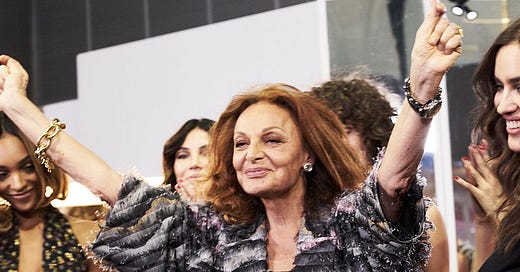
This piece was first published in our news digest, The Front Page. To get our latest scoops, investigations, and columns in your inbox every morning, Monday through Thursday, become a Free Press subscriber today:
The new Diane von Furstenberg documentary, Diane von Furstenberg: Woman in Charge, frames the 77-year-old Belgian designer as the world’s first girlboss: an entrepreneur unafraid to be sexy as she kicked down the doors of the boys’ club in her stilettos.
But while she is, yes, wildly successful and self-possessed, her animating principle isn’t progressivism or gender equality but an endless quest for freedom.
Von Furstenberg sought sexual freedom since she went to boarding school, falling in love with a man and then a woman in quick succession, and then, as she got older, everyone else. She said of leaving Prince Egon von Furstenberg, her first husband with whom she had two kids, “Divorce was freedom.” She described her iconic wrap dress, a form-fitting, printed jersey blockbuster as the “uniform for freedom.” She says of the crowd at Studio 54, “We thought we had invented freedom.”
She even chafes at the title of fashion designer, saying instead, “I had a vocation to be a free woman.”
Von Furstenberg’s obsession with being free is all downstream of the fact that her mother Lily was a prisoner of the Nazis, weighing 49 pounds when she was liberated from Auschwitz. Doctors told Lily it would be impossible to have a child. Soon after, Diane was born in Brussels, with a mission, it seems, to push liberation as far as she could.
Another wrinkle in the plot to make von Furstenberg into a boss babe fighting the patriarchy: she refuses to be a victim.
The director asks if any men made her feel uncomfortable early in her career. “I would never give anyone that much credit,” she says. A New Yorker reporter said that von Furstenberg “didn’t fit the mold” of a second-wave feminist because she “wore fishnet stockings and heels.” He asked von Furstenberg if she felt accepted by that movement, to which she offered, “I don’t know. I never asked them.” He then brings up sex positivity, to which von Furstenberg replies, “What did you say? ‘Sex-positive’? What does that mean?”
And unlike the girlboss of the 2010s, von Furstenberg doesn’t care how her image—which is of a rich, bisexual vixen—is received, or how her politics come off, or what it says about her that she married two fabulously wealthy men (her second husband is Barry Diller) who, we’re meant to understand, are both gay. It didn’t matter, and in the documentary, you see that she loves them both. Fidelity, domesticity, or stability were not the point of her marriages—freedom was—and they both offered her that.
There are drawbacks, though, to being this free. Her daughter describes being neglected while her mother went out on the town every night. She seems alienated from her own feelings, never crying in the movie and remarking flatly while looking at a cattle car, the same kind that would’ve shipped her mother to a concentration camp, “Crazy, huh?” She says she’s not afraid to die, even though she thinks about it “all the time.”
Most of us will never be as free as Diane von Furstenberg, and plenty of us don’t even want that level of freedom. She went the whole way with it, accepting that being free and doing what you want ups the risk of being burned, exposed, and judged. Like that perfect dress, she wears it with pride.
Suzy Weiss is a reporter at The Free Press. Read her piece “Hurkle-Durkle Is the New Way to Self-Care Ourselves to Death,” and follow her on X @SnoozyWeiss.





A warning of being careful of what you wish for, her freedom and her fierceness in attaining it, frequently admirable , had ,as pointed out above, its limits. She seems cut from the same revolutionary cloth as so many of the gay men I first encountered in NYC in the early 80's, vestiges of the libertine 70's. Heartbreakers frankly. "Free", if that is what you call it, but also self obsessed and frequently cold hearted. Monogamy , tradition , faith, duty and family building all points of laughter and ridicule. She seems , with her glamour and allure, the paragon of that ideal.
That said, I have long admired her work, her tenacity and I admit her glamour .
Appreciative of an article not so rooted in this very moment, a relief from the current discord.
For the title of First Girlboss one might more profitably look to less glamorous women, far from Paris and New York, like the late, great Rose Blumkin of Nebraska Furniture Mart.